|
|
|
Xylophone

Auris
PEXY211: 11 tone, c-diatonic, Marimba
PEXY107: 7 tone, pentatonic
PEXY108: 8 tone, c-diatonic
PEXY208: 8 tone, c-diatonic, Marimba
|

PEXY112
12 tone, c- diatonic
|
Is there anyone who does not know the Xylophone?
It is played in African areas as well in various South American and Asian countries. Each culture has its own look and sound. In the German-speaking regions the Xylophone was known by the name of Straw Fiddle or Wooden Laughter during the Middle Ages.
Carl Orff revived this ancient instrument around 1910 to be used in his “school works.” A simple but multifarious instrument.
Suitable for children, with or without musical knowledge.
The difference in sound depends not on the wood but mostly on the resonating chamber underneath; the sound of wooden plates does not last long compared to that ofmetal plates. Therefore it is very important to give the sound due space. In the case of the Xylophone is it a larger resonating box under the sound plates.
The Auris models consist of pine wood panels that can easily be put together. The heavy sound plates from Acacia wood rest on them loosely and can be changed. The sound is strong and clear.
Incl. 2 strikers
 |
Balafon

PEBA105 pentatonic
PEBA102 diatonic
|
The African Balafon is the ancestor of the family of idiophones like the Xylophone, Vibraphone, Marimbaphone and Glockenspiel. The culture of Balafon music is far advanced and still alive, especially in the countries south of the Sahel zone and the tropical rainforest area .
Balafon music reached its zenith in the 16th century at the royal court of Sikasso (Mali). With the generous promotion of the ruler at that time, the arts blossomed freely. The court musicians dedicated themselves to the development of their playing without any material hardship and brought the tradition of Balafon music to a high standard, influencing even non-African music.
Special features of the Balafon are the Calabashes, hollow pumpkins underneath the wooden sound plates that work as resonating chambers. The sides of the pumpkins are pierced at 2 or 3 places and covered with thin membranes. They start humming when the Balafon is played, producing an effect similar to that of the Kazoo.
According to different cultures the instruments vary in construction and sound. Therefore you will find different sizes and tunings. The most common are the pentatonic and a kind of diatonic tuning that sounds unusual to Westerners: it is the African natural scale.
 |
Sound Stool
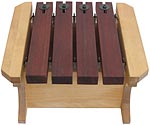
PEKH100 small
|
This instrument was made for durability and flexibility, and therefore is perfectly suitable for pre-school activities where it can also be used as a stool. It is almost indestructible due to its construction and the materials used (beech wood)
The sound stool is available in two sizes: a smaller and a larger one with 4 tones each. That’s why it is mostly offered in sets. Each single note is tuneable with a specially designed system, so one set offers the range of a full chromatic scale.
The sound wood is Padouk which is loved for its fulness of overtones. When the sound stool is played with Marimba sticks, its sound is almost identical to that of a professional Marimba. Of course, other strikers can be used as well.
 |
Slit Drums

PEST100
Big Tom, 120x40x40 |
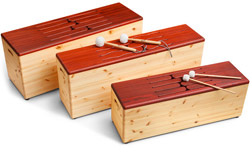
PEST200 6 tone pent.
PEST201 8 tone pent.
PEST202 12 tone diat. |

PEST203
10 tone, Wenge, 60x20x18 |
|
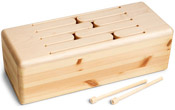
PEST205
8 tone, cherry, 50x20x15 |

PEST206
Tepo, 4 tone, cherry, 40x12x12 |
In the African, Latin-American and Indonesian cultures Slit Drums have been used as messenger tools for a long time. Originally it was a hollowed tree with a slit on the upper side to form two resonating sound plates. By drumming on these two plates people used to send messages over long distances.
In the course of time the instrument developed into a solid wooden box. A number of sound plates—it can be 4, 6 or 8—are cut out of the top. The sound depends on the wood as well as on the form of the sound plates. The Slit Drum is an ideal instrument for kids, and a tried-and-tested tool for therapists. But musicians can get their money’s worth too!
One can play on them freely and easily without any musical knowledge. They are tuned and available in different sizes (unfortunately not the original tree-size!). In a twinkling one can create a fascinating mixture of rhythm and melody. The solid construction guarantees long life even with intensive use. They are a pleasure for kids and adults alike.
Tepo: simple and solid, from cherry wood
Big Tom: Bass or Tenor; body from spruce, top from Padouk; one can sit or even lie on the drum while playing: the sound vibrates in every cell of the body. Ideal for music therapy and education.
 |
Waterphone
The Waterphone belongs to the category of the most unusal sound instruments man has ever invented. Its tones resemble whale songs or sounds from outer space – it even looks astonishing. The Waterphone was invented and patented 1967 by Richard Waters (nomen est omen!). Indeed, water plays a significant role here. The bowl-like body is filled with water and by moving it the sound varies amazingly. Several metal bars of differing length rise up out of it. They are played with a bow or even softly with strikers to produce those fantastically sustained overtones. By swinging the instrument around, the tones are changed in a ghostly manner. The filling level also determines the sound character.
The standard types are made from stainless steel, and also types from alpaca or bronze are available. We offer more than 10 different models.
 |
Marimbula
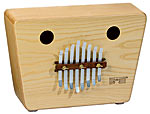
PEMA108
|
The Marimbula is the ancient bass of the Caribbean. It is related to the Kalimba. Eight metal bars are fixed in a holding device so they can be tuned separately. The scale goes from D to G. The resonating box measures about 40 to 60 centimetres. The instrument is tuned in f major pentatonic.
The Marimbula can be played with fingers as well as with mallets. If one plays with mallets the sound plates produce fresh overtones. When using a strap one can pluck the instrument while standing.

|
Kalimba
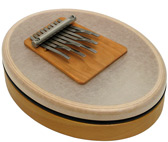
PEKL700
Sansula |
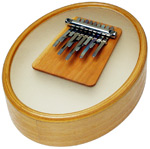
PEKL701
Sansula Renaissance | 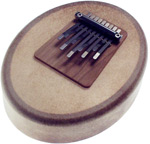
PEKL703
Sansula Deluxe |
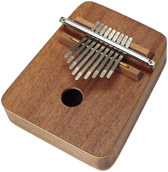
PEKL704
classic |
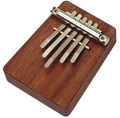
PEKL705
5 tone |
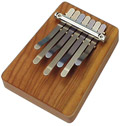
PEKL706
7 tone |
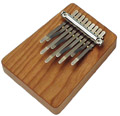
PEKL707
9 tone |
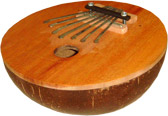
PEKL200
traditional untuned |

PEKL300
17-tone, with rattle effect |

PEKL500
pentatonic 11-tone |
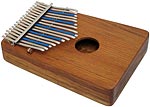
PEKL600
resonant body 17-tone |
For ages South African storytellers have used the so-called Thumb Piano to illustrate their stories. They are also known by the names Kalimba, Sanza or Mbira.
Metal bars like flat nails of different lengths and thicknesses are fixed on a simple wooden plate. The hollow pumpkin underneath serves as a great resonating chamber and amplifies the tones. Sometimes rings or chains around the bars create the additional snare sounds that African music is known for.
The instrument is held by both hands and the thumbs pluck the metal bars. In that way one can make gentle tones and create interesting rhythms. Although it's very simple the Kalimba has a wide interest.
The models we offer are highly developed musical instruments created by inspired specialists. They differ not only in shape but also in sound. Every type except the traditional one is tuned precisely and offers a large scale. With a little hammer one can (carefully!) push the sound bars in both directions in order to change the tuning a bit.
The Sansula is a special type of Kalimba built on a kind of little frame drum. Its sound is more sonorous, richer and much softer than that of a classical Kalimba. The metal bars are produced precisely, mostly tuned in pentatonic. If you hold the Sansula on your lap or over an even surface you can create intense effects like vibrato or Wah-Wah by lifting and lowering the whole instrument.
Thus you can make the tones “speak” or create atmospheric sounds. The simple way of playing and the wide range of sounds will charm you!
Sansula Renaissance is covered with a natural looking plastic skin, and is thus resistant to climatic changes. Sansula Deluxe is the most solid model, perfect for permanent use and the playful hands of children. It has a natural skin that can be tuned with a small key. For all models the tuning is the same (a minor with additional notes).
 |
Glockenspiel: Sonor
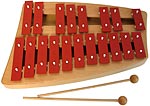
PEGL130
NG-30 19 notes |

PEGL110
NG-10 11 notes |

PEGL100
Mouse 8 notes |
The typical characteristic of a Glockenspiel for children is a special design with rounded edges and beautifully shaped holders for the strikers. Its sound is pure, perfectly suitable for children’s and adults' ears alike.
A Glockenspiel is a very popular and easy-to-learn instrument for kids. It offers the chance to quickly become familiar with notes and play simple melodies. Even very little children are enthusiastic about the bell-like melodious tones and don’t hestitate to play as soon as they get a striker in their hand.
These models are tuned in C major with a range of 1.5 octaves.
GS: low budget instrument for beginners, coloured plates on a plastic frame
NG-10: extra plates for F# and Bb, red sound plates on a wooden frame
NG-30: as above but with a second row for halfnotes
Mouse: have more fun with the mouse, coloured plates on wood, 1 octave
 |
Glockenspiel: Auris

PEGL203
triad
a-h-d / h-d-e / d-e-g
|
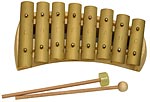
PEGL208
KDH-008 diatonic
8 notes |

PEGL212
KDH-012 diatonic
12 notes |
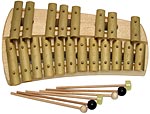
PEGL300
KKH chromatic
20 notes |
Pure, sweet, melodious sounds to please the ear for a long while!
It is loved by kids and adults alike. Whether it is a pentatonic or diatonic scale, you create magically beautiful melodies with it. The curved form with the round edges is also pleasing to the eye.
Incl. wooden striker
 |
Bowed Glockenspiel
 PESG100 |  PESG200
|
The bowed Minos Glockenspiel is designed so it can be comfortably pressed with the left hand against the body. The right hand holds the bow and passes it over the sound plates, like a violin bow over strings. This method gives the instrument more intense sonority: from pianissimo up to penetrating power. It is suitable for little children as well as for adults who are interested in a new world of sound. There are countless ways of using it in musical therapy and pre-school musical training, too.
The bowed Minos Glockenspiel is made in Switzerland and was honoured with the Ornamenti-award at the specialist Ornaris fair.
 |
Metallophone Orff

PEMF100 |
The Metallofone is related to the Glockenspiel and Xylophone, but the sound plates are made from metal, as the name suggests. These popular instruments are part of the Orff instrument set and thus are found quite often in schools and kindergartens.
In order to amplify the sound the Metallofone has a resonating chamber. The wooden box where the sound plates rest on is thus quite large so that each tone can last and resound sonorously. The sound quality depends on the size of the resonating chamber, the way the plates rest on it and the kind of metal they are made from. The strikers also play an important role.
The range of notes is about one and a half octaves. Additional replaceable sound plates serve as halfnotes.
Various factories have produced different types of this percussion instrument with an individual character. Please ask us for details.
 |
Pipedream: Tube Glockenspiel

PEPD100 |
At first sight they may not seem to offer an interesting musical experience, but the sound is clear and lasting. The pentatonic tuning suggests improvisation; it is ideal for musical newcomers. Being an effect instrument too it allows interesting sounds as the Energy Chimes do.
The two strikers allow one to play in chords. You can also pull the strikers alternately over all the tubes to create an unbroken sound wave.
 |
Energy Chimes
 PEEC100 Energy Chime C4
PEEC200 Energy Chime C5
PEEC300 Energy Chime F4
PEEC400 Energy Chime G4 |
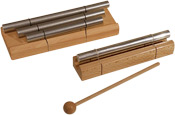 PEEC500
PEEC503 Trio
light and dark wood |
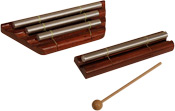 |
These chimes fascinate the listener with their pure and long lasting tones with clearly audible vibrations. A gentle stroke with the wooden striker is enough to create a clear sound.
In practice they stand the test in kindergartens or classrooms where attentive listening quickly leads to silence. People love to use it as a Tuning Fork as well.
The most common types are tuned in E´,A´and A´´. Other tones are available on request.
 |
Steel Drums
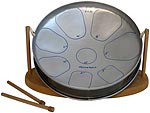
PESD100
Kid
pentatonic 7-tone |
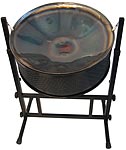
PESD200
Meditation Pan
pentatonic, F-min |
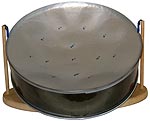
PESD300
Teacher
Soprano C-maj, 15-tone |
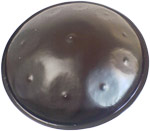
PESD400
Caisa |
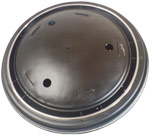
PESD400
Caisa |
The sound of the Steel Drum is inseparably connected with Caribbean culture. At the end of the 1930s the first Steel Drums came into being. In the beginning they were made from oil barrels and played as simple percussion instruments. Henceforth the Steel Drum developed into a professional melody instrument that is used in many musical genres. A remarkable result is that Steel Drum orchestras now perform complete orchestral works and impress listeners with their virtuosity.
The Steel Drum is a percussion instrument with concavely arched sheet metal. In this metal the instrument maker hammers sound fields of different sizes to give precisely tuned notes. They are played with rubberized strikers and produce a soft but intense sound.
Our choice:
Kid, for the little ones: perfect little Steel Drum for discovering and trying; F Major pentatonic, pithy sound, diameter: 33 centimetres; wooden table stand included.
Meditation Pan: a Steel Drum for improvisation, soft and typical Caribbean sound; F Minor pentatonic; 9 notes; diameter: 58 centimetres; metal stand sold separately.
Teacher: especially precise sound; alternate order of tones; C Major with F# and Bb; diameter: 45 centimetres; wooden stand included.
Caisa: The youngest child in the family of Steel Pans is the Caisa whose convex form is an inversion of the Meditation Pan. Some people even compare it with a UFO. The Caisa, which resembles the famous Hang, is perfect for playing with fingers; the most suitable technique is that of playing Tabla. Nevertheless all fingers, including thumbs, can be used, whereas only a short sharp stroke produces a satisfying tone. The Caisa consists of two round domes of special steel that are bound together with ropes. The instrument has a diameter of 60cm and is available in 5 tunings (mostly pentatonic scales). Stands of 2 heights and a foot stand are sold separately, as well a custom-made padded bag which is indispensable for safe transport. Meanwhile the Caisa is made with a black moisture-proof finish. Musicians with damp hands or those who live in countries with high humidity prefer these models, otherwise their precious instruments might corrode. The normal finish glimmers bluishly like the Meditation Pan.
Nowadays the Caisa has become a coveted percussion instrument, so be prepared to be wait-listed.
 |
Hapi Drum
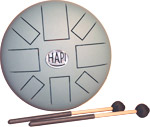
PEHP100 |
The Hapi-Drum (Hand Activated Percussion Instrument) is born of a new sound culture. It is a mix of Slit Drum and Steel Drum, and offers itself as an easy-to-play instrument for everyone. Produced for rhythmical-melodic improvisation, no musical knowledge is needed. Several sound plates of different sizes are cut out of the arched surface, which are played with strikers or sharp finger strokes. The tones make a pentatonic scale and are long lasting, thus producing a meditative mood. But the Hapi can be played in fast rhythms as well. This instrument is easy to handle, with a diameter of about 30cm, and can be carried in a suitable padded bag.
The Hapi can be played on the lap or a table, as it has rubber stands underneath.
At the moment the following tunings are available: D major, E-major and E-minor.
 |
Klangauge
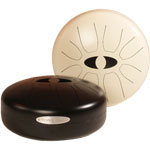
PEKA100
|

Sticks
PEKA120
|
The Klangauge (“sound eye”) originates in Germany and is the younger brother of the Hapi. While it is quite similar, the Klangauge surpasses the Hapi in some respects, such as having a smaller body, finer surface and more aesthetic appearance, typically “made in Germany”. The sound is longer lasting than that of the more percussive Hapi. Both instruments offer a large creative potential – for music therapy, free rhythmical improvisation and spontaneous jam sessions, as they do not demand any practice or technique. They can be played with fingers or strikers alike, so even small kids can have fun. The Klangauge offers a special kind of sound massage when being placed on the belly and played. The vibrations can then be felt in the body, similar to the well-known massage with singing bowls.
A special advantage of the Klangauge is the tuning: with the help of strong magnets the tuning can be changed from e-minor to f-major, both pentatonic scales. So one instrument offers two tunings. There are two colours available, cream white and black, along with a suitable felt bag, felt strikers and felt pad.
 |
Buttam
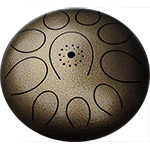
PEBT023 23cm, 10-tone
PEBT030 30cm, 10-tone
PEBT044 44cm, 11-tone
|
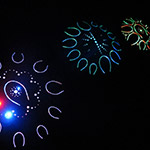
|
Resembling Hapi and Klangauge the Buttam presents itself as the youngest member of the family, of course showing unique aspects. The smallest model among the Buttam has only 23cm diameter but a really amazing and lasting sound. Its cuddly size and light weight make it a perfect traveler companion. The bigger models with 30cm or 44cm offer more volume and fulness. The Buttam has 10 or 11 tones of mainly pentatonic scale.
The uniqueness of the Buttam is but its luminosity that unfolds at night. All sizes can be equipped with LED-lights. Plugged into the socket it faszinates with blue and green rays of light shining mystically through the holes of the top. Definitely a hit at parties or jam sessions at night!
The Buttam is handmade in a small manufacture in Barcelona and produced with great care.
|
Sen-Plates

PESP105 blue
|

PESP205 silver-grey |
The inherent sound of metal can be expressed perfectly with the special tuning technique of Sen-Plates. Each tone can sound soft or powerful, according to the intensity and the way the plate is struck.
A special timbre is created by the corresponding pairs of sound fields, creating a subtle vibration of overtones.
The Sen-Plates are available as “six-flat” in two pentatonic tunings, enabling players to improvise freely and play interactively.
 |
Boomwhackers

PEBW006
pentatonic
6-tone |

PEBW008
slide
8-tone |

PEBW005
halftone, chromat.
5-tone |
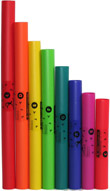
PEBW108 Bass diatonic, 8-tone
PEBW105 Bass additional set of halfnotes, 5-tone |

PEBW008
tuning caps
8-set |
Indeed they boom, these Boomwhackers from the U.S.!
They are precisely tuned tubes made from almost indestructible plastic. They are perfect for kids and adults alike, to discover the world of sound and rhythm without much financial or technical effort.
A set of Boomwhackers consists of different tuned coloured plastic tubes. You can either strike them against the leg or the palm or any other solid objects around you. The volume varies according to the surface, but the tuning is always the same.
Each player can hold one or two tubes; it’s just a matter of paying attention to coming in on time. You can play simple melodies as well, even chords. You can change the tuning of a tube by putting a plastic cap on top.
There are sets in pentatonic, diatonic and chromatic tuning over two octaves. Each tone corresponds to a colour (for example C = red). Ideal for musical pre-school training, kindergartens, schools, musical therapy, group games... you may even inspire inveterate non-musicians!
 |
Set of Bells

PGS100 40-70mm, grips in bird shape, exactly tuned
| 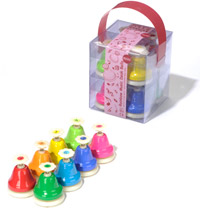
PGS400 table bells to tick on, small
PGS500 table bells to tick on, large
|
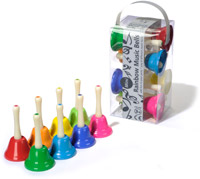
PGS200 small, with grip, high octave
PGS300 large, with grip, low octave
|
These multi-coloured bells are most suitable for cheerful playing in groups – enjoyable for kids and adults alike. The set consists of 8 tones in C-major. The high and low octave can also be combined to widen the variety. We offer budget and high quality sets.
 |
Harmonium, Dalsetina & Shruti Box
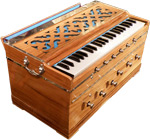
Harmonium PEHA100
|
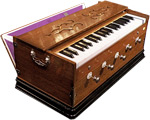
Harmonium PEHA200
|
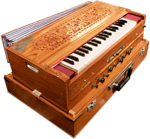
Harmonium PEHA300
|
| 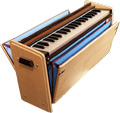
Dalsetina PEDA100
|

Shruti Box PESB100
|
The Harmonium was originally brought to India by Christian missionaries from Europe to be a mobile replacement for the organ.
Today it is not possible to imagine Indian music without the Harmonium. Its simple use has made it popular not only in India, but in the West too.
The Harmonium has keys like the piano and bellows that are pushed by one hand. The sound is created by the air streaming over the tuned metal plates inside. According to the type there are registers for lower and higher pitch, for doubling the octaves, regulation of the volume, vibrato and various bordunes. Indian harmoniums have a practical size and a soft voluminous sound.
The Dalsetina is a slim and easy-to-handle version of the Harmonium. It does not have any registers to vary the tone. Its advantage is the construction and its light weight. Its sound is quite powerful but not so rich in modulation as in the case of the “adults”.
The Shrutibox is used to produce lasting sounds. The construction style is the same as with the Harmonium, but the inner space is smaller and thus much more practical. The range of notes is one octave.
In India the Shrutibox is an accompaniment in traditional music; in the West it is mainly used for overtone singing.
 |
Melodica
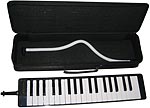
PEME100
|
The Melodica presents itself as an easy-to-play instrument for kids and for adult beginners. The keyboard is similar to that of a piano and offers a scale of two or three octaves. However, the sound comes out only if you blow simultaneously into the mouthpiece. The Melodica is a combination of a key and wind instrument. The mouthpiece can be fixed onto a tube, hence the instrument can be placed on a table while playing.
It is an interesting fact that the Melodica nowadays is used for Balkan and Klezmer music—the sound fits perfectly. It is also easy to learn and to carry. A bag for the melodica is included.
We offer a low budget instrument made by Walther and a model of higher quality made by Hohner.
 |
Accordion
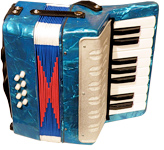
PEAK100 |
The Accordion looks back at a long and rich musical tradition and still enjoys much popularity in many music genres. Whether Balkan music, Polka, Irish Folk, French Chanson or Klezmer — the Accordion suits almost every taste.
This Piano Accordion has 48 bass notes and a diatonic scale with 12 notes. The Piano-Accordion we offer here is preferably played by pupils as it is smaller and lighter than professional instruments. But also adults who have problems with the weight of the large types do well with this smaller one. Here we offer a low budget model but, a top quality one made by Hohner is also available. This well-known German factory has been produced top quality Accordions for 150 years, and sells them to leading musicians all over the world. On request we order whichever type you wish.

|
Kids’ Accordion
 PEKH014 Melodium |
 |
An instrument that fascinates children again, and again!
The reason for that is probably the interesting bellows whose movements create wonderful sounds. Or is it the sense of adventure, as it reminds one of a ship’s Accordian, sailors, the ocean and long journeys?
Anyway, this Accordion is a handy model for kids.
Melodium has 14 notes, a diatonic scale and a nice timbre so you can create a pleasant sound with it.

|
Concertina
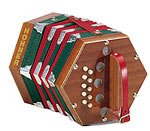
PECT100 |
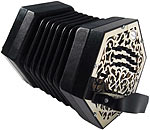 |
When the Anglican Concertina came into existence it was meant for a more sophisticated audience. Nevertheless this instrument boomed in England, evident from the fact that in 1850 there were 100 factories. The concertina was ornamented in a luxurious way; some of them had gold or silver knobs.
The Anglican Concertina typically has an uninterrupted chromatic scale, arranged left and right, making it an ideal melodic instrument.
We offer three types: two made from wood or plastic with 20 knobs, one made from plastic/metal with 30 knobs.
 |
Sticks

BigBom
ZUBB001
Felt head, yield, in pairs |

Glockenspiel
ZUGS001
Please indicate model in order |

Sound Stool
ZUKH001
Please indicate model in order |

Metallophone
ZUME001
Please indicate model on order |

Steeldrum
ZUSD001
Please indicate model on order |

Slit Drum
ZUST001
Please indicate model on order |

Soft Striker
ZUSS001 large
|

Soft Striker
ZUSS002 small
|
 |
|
Copyright © Gandharva Loka |

